
By Fiona Kubalak, age 11
In Latin, Lemur means wandering spirit and that pretty much sums up these adorable wide-eyed creatures. Leaping from tree to tree these fuzzy lovable primates will captivate the audience. Not only does Island of Lemurs: Madagascar, which opens at the Pacific Science Center on April 4, teach you about how Lemurs habitats are changing, some awesome facts about them, and what you can do to help them, it shows us stunning views of Madagascar’s peaks and forests. We also meet primatologist Dr. Patricia C. Wright who is working tirelessly to bring back the Greater Bamboo Lemur.
The movie begins with the story of the lemurs from the age of the dinosaurs and shows how they moved from Africa to the uninhabited island of Madagascar. There are many different types of lemurs like the Mouse, the Ring-tail, the dancing Sifaka, and the large Indri which has a call that sounds like opera singing. All of these miraculous beasts come together to form the family of lemurs.
I found the Ring-tailed lemurs the most facinating because the females (even the youngest) are dominant over all the males in their society. They are also the best at adapting to the changing environment of Madagascar. They have moved from the forest, which is being burned to clear land for farming and livestock, to the rocky hills where there are no people to bother them. I also found the Mouse lemur interesting and cute because they are so fierce but also so tiny. The Sifakas are fun to watch because of the way they dance when they run and bounce on the ground and leap through the trees.
I would recommed the 3D IMAX film Island of Lemurs: Madagascar to kids 5 years old and up. This creative nature film was produced and directed by the same people who made Born to be Wild 3D and it was narrated by Morgan Freeman.